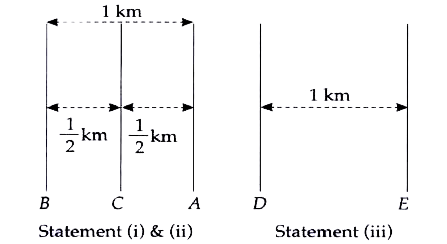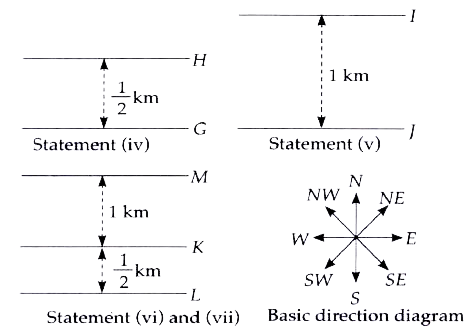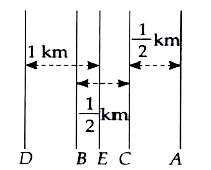All the roads of a city are either perpendicular or parallel to one another. The roads are all straight. Roads A, B, C, D, and E are parallel to one another. Roads G, H, I, J, K, L and M are parallel to one another.
(i) Road A is 1 km east of road B.
(ii) Road B is 12 km west of road C.
(iii) Road D is 1 km west of road E.
(iv) Road G is 12 km south of road H.
(v) Road I is 1 km north of road J.
(vi) Road K is 12 km north of road L.
(vii)Road K is 1 km south of road M.
If E is between B and C, which of the following is false?
D is 2 km west of A
C is less than 1.5 km from D
Distance from E to B added to distance of E to C is 12 km
E is less than 1 km from A
The correct Answer is:A
Information in statements (i), (ii) and (iii) be summerized by the following figures:

For statements (iv), (v), (vi) and (vii) the following figurative representations

If E is between B and C, we will have the following figure:

From the above Fig., it is dear that the statement .D is 2 km West of A. is false.
Topper's Solved these Questions
- BOOK - LUCENT PUBLICATIONCHAPTER - DIRECTION SENSE TESTEXERCISE - Exercise96videos
DIRECTION SENSE TEST
- BOOK - LUCENT PUBLICATIONCHAPTER - DECODINGEXERCISE - Exercise -210videos
DECODING
- BOOK - LUCENT PUBLICATIONCHAPTER - INSERTING MISSING CHARACTERS IN FIGURESEXERCISE - EXERCISE - 1166videos
INSERTING MISSING CHARACTERS IN FIGURES
Similar Questions
Road To Peace
View SolutionAll the roads of a city are either perpendicular or parallel to one another. The roads are all straight. Roads A, B, C, D, and E are parallel to one another. Roads G, H, I, J, K, L and M are parallel to one another.
(i) Road A is 1 km east of road B.
(ii) Road B is 12 km west of road C.
(iii) Road D is 1 km west of road E.
(iv) Road G is 12 km south of road H.
(v) Road I is 1 km north of road J.
(vi) Road K is 12 km north of road L.
(vii)Road K is 1 km south of road M.
Which is necessarily true ?View Solution
Knowledge Check
- Question 1 - Select One
All the roads of a city are either perpendicular or parallel to one another. The roads are all straight. Roads A, B, C, D, and E are parallel to one another. Roads G, H, I, J, K, L and M are parallel to one another.
(i) Road A is 1 km east of road B.
(ii) Road B is 12 km west of road C.
(iii) Road D is 1 km west of road E.
(iv) Road G is 12 km south of road H.
(v) Road I is 1 km north of road J.
(vi) Road K is 12 km north of road L.
(vii)Road K is 1 km south of road M.
Which is necessarily true ?AE and B intersectBD is 2 km west of BCD is at least 2 km west of ADM is 1.5 km north of L - Question 2 - Select One
All the roads of a city are either perpendicular or parallel to one another. The roads are all straight. Roads A, B, C, D, and E are parallel to one another. Roads G, H, I, J, K, L and M are parallel to one another.
(i) Road A is 1 km east of road B.
(ii) Road B is 12 km west of road C.
(iii) Road D is 1 km west of road E.
(iv) Road G is 12 km south of road H.
(v) Road I is 1 km north of road J.
(vi) Road K is 12 km north of road L.
(vii)Road K is 1 km south of road M.
If road E is between B and C then distance between A and D is:A12 kmB1 kmC1.5 kmD1.5-2 km - Question 3 - Select One
All the roads of a city are either perpendicular or parallel to one another. The roads are all straight. Roads A, B, C, D, and E are parallel to one another. Roads G, H, I, J, K, L and M are parallel to one another.
(i) Road A is 1 km east of road B.
(ii) Road B is 12 km west of road C.
(iii) Road D is 1 km west of road E.
(iv) Road G is 12 km south of road H.
(v) Road I is 1 km north of road J.
(vi) Road K is 12 km north of road L.
(vii)Road K is 1 km south of road M.
If E is between B and C, which of the following is false?AD is 2 km west of A.BC is less than 1.5 km from DCDistance from E to B added to distance from E to C is 1/2 km.DE is less than 1 km from A.
All the roads of a city are either perpendicular or parallel to one another. The roads are all straight. Roads A, B, C, D, and E are parallel to one another. Roads G, H, I, J, K, L and M are parallel to one another.
(i) Road A is 1 km east of road B.
(ii) Road B is 12 km west of road C.
(iii) Road D is 1 km west of road E.
(iv) Road G is 12 km south of road H.
(v) Road I is 1 km north of road J.
(vi) Road K is 12 km north of road L.
(vii)Road K is 1 km south of road M.
If K is parallel to I and K is 12 km south of J and 1 km north of G, which two roads would be 12 km apart?View SolutionAll the roads of a city are either perpendicular or parallel to one another. The roads are all straight. Roads A, B, C, D, and E are parallel to one another. Roads G, H, I, J, K, L and M are parallel to one another.
(i) Road A is 1 km east of road B.
(ii) Road B is 12 km west of road C.
(iii) Road D is 1 km west of road E.
(iv) Road G is 12 km south of road H.
(v) Road I is 1 km north of road J.
(vi) Road K is 12 km north of road L.
(vii)Road K is 1 km south of road M.
Which of the following possibilities would make two roads coincide ?View SolutionAll the roads of a city are either perpendicular or parallel to one another. The roads are all straight. Roads A, B, C, D, and E are parallel to one another. Roads G, H, I, J, K, L and M are parallel to one another.
(i) Road A is 1 km east of road B.
(ii) Road B is 12 km west of road C.
(iii) Road D is 1 km west of road E.
(iv) Road G is 12 km south of road H.
(v) Road I is 1 km north of road J.
(vi) Road K is 12 km north of road L.
(vii)Road K is 1 km south of road M.
If road E is between B and C then distance between A and D is:View SolutionAll the roads of a city are either perpendicular or parallel to one another. The roads are all straight. Roads A, B, C, D, and E are parallel to one another. Roads G, H, I, J, K, L and M are parallel to one another.
(i) Road A is 1 km east of road B.
(ii) Road B is 12 km west of road C.
(iii) Road D is 1 km west of road E.
(iv) Road G is 12 km south of road H.
(v) Road I is 1 km north of road J.
(vi) Road K is 12 km north of road L.
(vii)Road K is 1 km south of road M.
If K is parallel to I and K is 12 km south of J and 1 km north of G, which two roads would be 12 km apart?View SolutionAll the roads of a city are either perpendicular or parallel to one another. The roads are all straight. Roads A, B, C, D, and E are parallel to one another. Roads G, H, I, J, K, L and M are parallel to one another.
(i) Road A is 1 km east of road B.
(ii) Road B is 12 km west of road C.
(iii) Road D is 1 km west of road E.
(iv) Road G is 12 km south of road H.
(v) Road I is 1 km north of road J.
(vi) Road K is 12 km north of road L.
(vii)Road K is 1 km south of road M.
Which of the following possibilities would make two roads coincide ?View Solution

